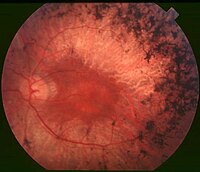
Photo from wikipedia
This study aimed to investigate the mutation spectrums and ocular features of Alström syndrome (AS) patients. Six AS patients from five unrelated families were included. Ocular and systemic examinations were… Click to show full abstract
This study aimed to investigate the mutation spectrums and ocular features of Alström syndrome (AS) patients. Six AS patients from five unrelated families were included. Ocular and systemic examinations were performed in all subjects. Whole-exome sequencing (WES) was performed in the probands, and Sanger sequencing was performed for mutation validation and segregation analysis. Among the six patients, the first symptoms included nystagmus, poor fixation, and photophobia. Five patients had high hyperopia, four of whom (80%) were initially diagnosed with amblyopia before referral with prescribed corrective lenses and amblyopia treatment, but no improvement was obtained. Optical coherence tomography (OCT) revealed progressive damage to the photoreceptor layer, including blurred ellipsoid zone (EZ) and lack of interdigitation zone (IZ) within the macula, and thorough loss of photoreceptor layer in the peripheral retina. Electroretinograms (ERG) demonstrated severely diminished cone and rod responses. WES identified biallelic variants of ALMS1 in all the six patients, including two novels, c.3892C > T (p.Gln1298*) and c.2888_2897del (p.Ser963Thrfs*15) and five knowns, c.10819C > T (p.Arg3607Trp), c.2090C > A (p.Ser697*), c.4891C > T (p.Gln1631*), c.10825C > T (p.Arg3069*) and c.6430C > T (Arg2146*). In conclusion, this study expanded the ocular features and genotypic spectrum of AS. High hyperopia is a significant and common feature of AS. OCT and ERG are essential accessory techniques for the diagnosis of AS. If a patient had high hyperopia with a noneffective response to amblyopic treatment, the diagnosis of AS should be suspected, and detailed ocular examination, systemic evaluation, and genetic testing recommended.
Journal Title: Experimental eye research
Year Published: 2022
Link to full text (if available)
Share on Social Media: Sign Up to like & get
recommendations!